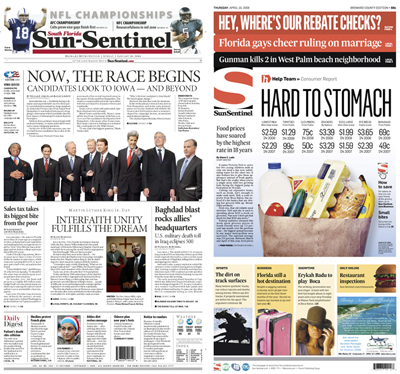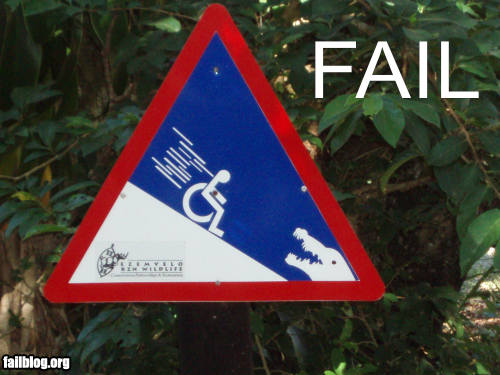Google CEO Eric Schmidt, whose company has played a critical role in the destruction of the US newspaper industry, bemoaned the decline of investigative journalism, a discipline he called “fundamental to how our democracy works,” in remarks at the the recent Ad Age Madison & Vine conference in New York. The executive said a fundamental challenge to the industry is that readers are spending less time on content and thus less time being monetized. The idea that new advertising models will emerge to support quality journalism after the newspaper industry collapses is misguided. “The evidence does not support that view,” he said.Schmidt observed that newspapers are being challenged by the triple whammy of advertising competition, high newsprint prices and a decline of non-targeted advertising. “These guys are in a world of hurt and we as a community need to find economic models that will fund really great content,” he said. He noted ruefully that sketchy coverage of the war in Iraq is a particularly compelling example of the loss of investigative resources.
Redesigns Called “Reinventions”
 That’s the South Florida Sun-Sentinel before (left) and after its forthcoming redesign. Or should be say the SunSentinel? That’s right. As Charles Apple wryly notes, amid the cutbacks at Tribune Co., the new SunSentinel has laid off a hyphen.
That’s the South Florida Sun-Sentinel before (left) and after its forthcoming redesign. Or should be say the SunSentinel? That’s right. As Charles Apple wryly notes, amid the cutbacks at Tribune Co., the new SunSentinel has laid off a hyphen.
Apple quotes SunSentinel design director Paul Wallen saying, “Although our median reader is in the mid to late 50s, our target audience is almost a generation younger. We’re after occasional readers, people who don’t feel they have the time or enough interest to read our paper on a regular basis…We want the paper to feel vibrant and alive, much like the community it serves.” The new design formally launches on Sunday. To get a larger (and different) example, click on the image at left.
Another Tribune Co. property, the Baltimore Sun, will debut a new design on Aug. 24. No prototypes are being floated yet, but Editor & Publisher quotes Sun publisher Tim Ryan saying the overhaul is a “reinvention.” There’ll be three sections: news, sports and features. The features section will be called “You” in a nod to the complete USATodayification of the American newspaper industry. Tribune Chief Innovation Officer Lee Abrams called the Sun redesign “a tour de force package that’s going to help re-write the Tribune Co. — and newspapers.” We’ve already shared our opinion on the business value of redesigns.
Milwaukee Feels the Pain
The Milwaukee Business Journal writes of forthcoming layoffs at the Journal Sentinel as the paper struggles to meet its goal of a 10% staff cut. The piece illustrates the scope of the industry’s pain. Milwaukee should be a good newspaper town. It’s got a solid blue-collar middle class, people who don’t change their habits very quickly. The Journal Sentinel has a near-monopoly position, with 70 percent readership among Milwaukee adults on Sundays and about 50 percent on weekdays. Yet ad revenue is down 13 percent so far this year on top of an 8 percent decline in 2007 and 4 percent in 2006. Sunday circulation is down 16% from a decade ago.
The story has the obligatory Newspaper Association of America quote about combined print/online audiences being larger than ever, but the nut graph is a quote from a Morningstar analyst: “For every dollar daily newspapers have lost in print revenue, they’ve been able to replace it with only 15 cents in revenue from their Web sites.” The only way newspapers can survive the online shift is to get smaller, the analyst says. It’s just that no one knows how small they have to get.
A Journal Sentinel columnist is taking a buyout package and looking ahead. In this wistful, but ultimately uplifting farewell column he reminisces on the joys and frustrations of journalism and looks forward to taking a chance and spending some time with his family.
Miscellany
Former New York Times editor John Darnton recently retired from the paper. But instead of writing a tell-all memoir, he’s aired some dirty laundry in the form of a murder mystery called Black and White and Dead All Over (order it on Amazon). Reviewer Seth Faison knows many of the people who appear in Darnton’s fiction, including Publisher Arthur Sulzberger and Executive Editor Bill Keller. Faison praises the book for offering candid insight on the politics, chaos and juvenile behavior that characterizes a city newsroom. Darnton may lose friends as a result of this bitingly satirical work, but he’s made for darned good summer reading.
Tucson Citizen assistant city editor Mark B. Evans has some kind words for political bloggers who are, in some cases, outclassing the area’s newspapers in political coverage. We ignore these new voices at our peril, he says. Newspapers are falling further behind, so why not welcome these emerging opinion leaders into our fold and benefit from the readership and revenue they can bring?
The Lexington (Ky.) Herald-Leader is trying to further reduce staff through buyouts. Kentucky’s largest newspaper already cut its workforce from 417 to 382 in June, but that wasn’t enough. Executives didn’t set a target figure for this round of cuts.
The Christian Science Monitor‘s Jan Worth-Nelson has quietly, subtly replaced her morning newspaper with a MacBook and an RSS feed, but she still remembers the days when reading the Sunday paper was a treasured ritual. Sadly, cutbacks at the LA Times have made the paper less relevant to her Sunday mornings and she misses the thrill that came with snapping open that first issue of the day to drink in the fresh news that it promised.
Howard Rheingold has an interesting essay on how to get more out of Twitter. Best advice: keep the list of people you’re following short and engage in meaningful interactions with them. He also doesn’t tweet what he had for breakfast. (via Mark Hamilton)
End of an era: In a nod to the realities of advertiser pressure and a weakening print market, Rolling Stone will ditch is unique, awkward trim size and switch to a standard format effective with the Oct. 30 issue. The magazine’s size will be reduced from 10″ x 11 3/4″ to 8″ x 10 7/8″.
And Finally…

People always celebrate success, but they don’t give enough credit to really creative failure. Thank goodness, then, for The Fail Blog, a photographic tribute to failures big and small. Don’t look at this site in the office. Your colleagues will wonder why you’re laughing so hard. And don’t, under any circumstances, view it while you’re drinking milk, if you know what we mean.
Comments
This entry was posted on Tuesday, August 12th, 2008 at 7:59 am and is filed under Facebook, Fake News, Hyper-local, Paywalls. You can follow any responses to this entry through the RSS 2.0 feed. Both comments and pings are currently closed.



The Tribune redesigns are a disaster waiting to happen. They are seeking younger readers but will just end up forcing the older readers to cancel that crap of a newspaper. Tribune is by far the worst of the media companies. Ugh!!
Paul,
With so much good news at the Tribune Company the Fail Blog was a much needed relief, laughter is still the best medicine.
Thank you
investigate rumors of L-3 comm layoffs
State of the union address pull out of Iraq and Pelosi military budget freeze combine with loss of SOFSA contract to shake L-3 management and stockholders
as defense stocks tank. rumors of layoffs abound at L-3 comm lexington facility
managers told to prepare lists of those who should be let go in the first round
sagging defense contracts and internal management problems weaken company’s
ability to compete in the market
many employees ahve quit
anon